JUMP CUT
A
REVIEW OF CONTEMPORARY MEDIA
![]()

Liz’s meeting with her lawyer about the court report. Liz: "The court appointed a solicitor to write a report on what would be in John’s best interests. He wanted to know about my present living circumstances, why the relationship had broken up as well as how we had agreed to have a child.”


Margaret comments on the court report: “There would need to be substantial evidence for the assumption that the child should be with his mother to be overturned…but he does say without any real problems that you should get access.”

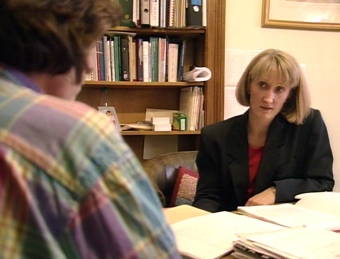
Liz: “If I could get access and Susan will go along with that and that affords me some protection of my rights and responsibilities, I don’t see there would be any point in trying to pursue the custody.”


Liz driving to court: “I hope Susan won’t be there this morning – I’ll find that really difficult if she is….I am glad I am going to court this morning – I don’t think I could cope thinking people will be discussing what’s going to happen without me being there.”


Liz and her lawyer walk from court ...


... and discuss her hearing.


Liz tells us she has been granted access by the court.


Liz and her lawyer discuss the hearing.

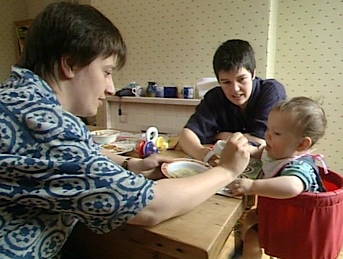
Steph Sharron and their son in Child of Mine: Steph says: “I sometimes felt that Sharron had the nice job of putting the milk in and ..."

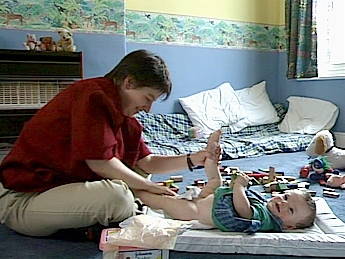
"... I had the nasty one of clearing it out at the other end. I mean we have always shared things like doing his nappies equally ...


"... I just missed out on the pleasurable bit of feeding him.”

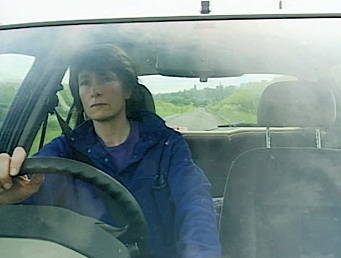
Liz driving: “John was six and a half month’s old when Susan and I split up…I left for a break and I never went back.”


Donna W. and Donna C.: Donna C. says: “I’ve always been his ‘mam’ …He’s stuck on that. If you said that’s his mam, he will say ‘No, that’s me ‘mum’ and that’s me ‘mam’.”

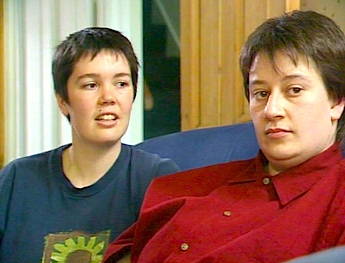
Steph and Sharron. Sharron says: “I can’t think of him not having contact with Steph if we did split up.”


Liz: “I have swung from one extreme to the other. I have felt like ‘I am John’s mother therefore I should have everything’ to the other ‘I am nothing therefore I should have nothing rather than being able to find some middle ground and being able to define my own role.’”

The ambivalence that I felt in relation to my position vis-à-vis Liz is particularly evident in one section of the film itself. We were, unsurprisingly, not able to film inside the court at Liz’s first appearance to seek access to her son. So we filmed her driving to court, as she came out of the court building, and in the car afterwards with her lawyer. We put a radio microphone on her so we could tape her conversation with her solicitor as she walked away from the court building, not least because we did not want to surprise Susan if she was there. In the final film we used all of the very long shot of Liz and her solicitor, Margaret, walking away from the court as we hear Liz speaking at normal volume about what has happened:
“Oh gosh, I was really anxious. As time was going on I was getting more and more uptight and I felt myself going red in the face. Because it seemed like initially he was going to go with everything and be really liberal about it and then he started to be persuaded about what Susan’s solicitor was talking about. So I started to get really very anxious then.”
We then cut to a medium close up of the two women sitting in Margaret’s car looking towards the camera and smiling as we hear me ask: “So how did it go? What’s the result?” Liz replies,
“Oh it went really well. I am going to get access twice a week, Mondays and Friday mornings for three hours, it’s brilliant.”
This is followed by a rear view, silhouetted shot of the two women in Margaret’s car in a staged conversation where they reveal further details of the court debate.
Margaret: “He was concerned about the psychological effects that it might have on a child with two mothers — as he kept referring to — but he has actually ordered of his own volition, a psychologist’s report.”
Liz: “Which I am quite happy to participate with obviously because I do have John’s best interests at heart and hopefully this will establish beyond any doubt that there will be no adverse psychological effects of me having a part in his life.”
The shifts in address in this sequence highlight the uncertainty of my relation to Liz’s story. We move from a highly contrived piece of “observation” where we appear to be eavesdropping on the protagonists (which implies we must have heard the result of the hearing) to a shot with her addressing the camera where Liz tells us the result. The two sequences query the reality effect intended in each, since they inadvertently reveal their own constructedness.
I veered between identifying with Liz and keeping a professional distance, a conflict which was exacerbated by the context of making the film in this unusual context — for a lesbian magazine program on a major television channel, where the partly observational style I felt obliged to follow seemed out of keeping with my identification with the main character. It brought home the tensions between an observationalism, where those in front of the camera are constituted as the “other” or the “what” of the film, and the more reciprocal relations of feminist and lesbian politics, which makes such objectification problematic.
Re-interviewing Liz:
politics, mediation and visibility
“One perceives that documentaries are not exactly about others, but about how documentarians portray others. The representation of any thing is the creation of another thing. In the case of documentary, this other creation is a character.”[20][open endnotes in new window]
So far I have outlined the professional and political reasons why I felt that my utilization of Liz’s story was legitimate and the ways in which I justified to myself the use of the footage involving her at different stages of the production. Nonetheless questions remained during and after the program’s completion, which became more acute in the wake of the press coverage.
Understandings, agreements and contracts which are in place at the outset or during the course of a production may come under pressure by the time the film hits the screen. Its images and ideas circulate in different ways among diverse sections of the audience and its meanings are mediated through publicity and other media. So many factors intervene between the moment of meeting, the scene of filming, and the time of the film’s appearance in the public realm that a film’s circulation inevitably has unforeseen consequences. Directors don’t necessarily know what meanings will emerge in post-production or how aspects of the film will be appropriated in ways they never intended in different contexts of circulation and exhibition. In this light, John Stuart Katz and Judith Milstein Katz point out the complexities of the notion of informed consent:
“Informed means that the person know to what he or she is consenting … Does he anticipate how his life may change when the film is shown; how neighbours, friends or business associates might respond to his (possibly distorted) views? Last but not lest how might he be affected by reviewer’s opinions even when the filmmaker and he like and agree upon the fairness of the representation.”[21]
Although I had kept in touch with Liz throughout the edit and airing of the film, I had not, for reasons that should now be clear, talked much with her about how she felt about her participation in the film and her commitments to it. Conducting a fuller interview with her would allow her to extend and interrogate the way she had been represented and would give me an insight about how she now perceived what had happened to our original understanding of the film’s aims and content. Now, as an academic, I also felt that this kind of enquiry into the experience of media participants would redress an imbalance in critical writing where issues of ethics are often discussed in quite general terms rather than through this kind of empirical engagement with those represented, whose voices are seldom heard except in a few high profile cases of complaint within the media themselves.
I went to re-interview Liz in July of 2009 to see what she would actually say about the impact the finished film and the process had had on her. Inevitably her perspective in this recent interview is given, like mine, with considerable hindsight, where she recalls and interprets events in the light of her subsequent history.
It was 13 years after we had made the documentary. I didn’t ask her to be filmed and I didn’t ask to go to her home. Instead she agreed to meet in a more neutral, informal space, a café, and I recorded a sound interview with her there. By adopting this approach, I wanted her to avoid her feeling that this was a continuation of the film but instead a critical enquiry to which she was contributing under, as stated above, research governance guidelines, with the right to veto the inclusion of material that she was not happy with. It emerged that she had indeed got back together with Susan shortly after the filming. Despite the difficulties of the relationship they had had another child, a daughter, together. When we met this year they had only just broken up again.
How strange that I should appear again in her life at this point, although this time the situation was much calmer and the couple were making arrangements together regarding access to the children. Liz had not recently looked at the film so her responses were based on memory. She did not have much to say about how she felt she came over in the film. When I asked her why she decided to take part, she said she “was someone who likes to feel I am doing something, registering a comment, contributing to a debate that could only happen with that film happening.” In that respect she and I had congruent goals for the film.
There were two things she was unhappy about. First, she didn’t like the fact that “her story was not followed all the way through.” I asked her to confirm whether I had told her there would be other stories and she said yes, but that the context was wrong. Essentially she thought the other stories cast her in a bad light, since those lesbian co-parents had obtained legal rights with the consent of their partners. She rightly understood that her story became by comparison a moral tale about the struggles one would face trying to get those rights after an acrimonious break-up. Within a narrative which highlighted the new legal acknowledgement of non-biological parents, Liz could be read as the “fall guy” character.
During the editing process, Liz moved from being the narrator of her own story in front of the camera to becoming a character in a narrative told by someone else. This created a sense of alienation, even though this is commonly how a complex situation is reduced in the process of translation into film. This sense of reduction is also something that I experience as director. As João Moreira Salles describes it, the director becomes subordinated to the process of a film’s narrativization:
“After a few weeks in the editing room, the director too becomes hostage to the film. The theme imposes its priorities, and the structure leads the narrative along paths that allow no diversions … The paradox is this: potentially, the characters are many, though only one person was filmed. In my opinion, herein lies the true issue of documentary.”[22]
So the film apparently did not favor Liz even though her story remained its most compelling part because of the conflicts she was going through before our eyes and because her story raised a lot of questions about what it means to be a parent. My editor, Anna Liebschner, said she kept wanting to come back to this ambivalent figure — but because the filming was curtailed we just did not have enough of her story.
Another surprising issue that Liz emphasized was about recognition. She was struggling, she said, to be recognized as a parent and by taking part in the film, she was also seeking other kinds of recognition — affirming the significance to others and herself of the battle she was engaged in. However, in giving her visibility, the film also opened out on to other issues about who she was and defined her in ways she then felt uncomfortable with. One thing in particular that she and her partner had been particularly unhappy about was that one of the other couples in the film “looked like a typical lesbian couple, they looked a bit “diesel dykey” and she found it “really difficult that I was on a program like that.” The film contextualized her in a way she wanted in some way to disavow — creating she what she felt was a stereotyped and limiting version of her identity. Although I might have anticipated that her story would be taken up in a sensationalizing way, as happened in the press, I don’t think I could have foreseen that she would regret the association with other lesbian couples or at least the “look” that signified their lesbianism. In the context in which it appeared in the film, Liz’s story becomes that of “another lesbian” in a way she found not empowering but disempowering. It seems Liz felt torn between being affirmed as a lesbian and being constrained by such a naming.
Adriana Cavarero discusses this problem as she draws on a reworking of Hannah Arendt’s work to theorize the shared space of narration and thus “ontological affirmation” created by the exchange of life-stories within the women’s movement and in consciousness-raising specifically. She notes a contradiction in the process of feminist consciousness-raising:
“In the reflection of the one in the other, the very personal identity that is consigned to the tale of an unrepeatable life-story runs the risk of losing its expressive reality and founding itself in the common ‘being women’ that is represented here. ‘I am you, you are me,’ the words which one says are women’s words, hers and mine.”[23]
Another issue came up around the question of recognition:
“Not a lot of people that I knew saw it — I certainly didn’t tell people about it. It wasn’t something I wanted broadcast. It wasn’t there for people that I know. It was there for other people to make them think, as far as I was concerned. I got stopped one day when I was at work, when going out to meet someone at hospital. I got stopped by the receptionist and she said I just want you to know I think you are really brave and I wish you luck. Someone had recognized me and I was really touched but also shocked — the idea that someone could actually give me some sort of celebrity status. So I went straight back out and got my hair all cut off. I thought oh my God I don’t want people recognizing me — I went into the hairdressers and said I want my hair cut really short. I decided I wouldn’t wear any of the clothes I’d worn when we were filming and they would just go in a bag and I’d take them to a charity shop because I didn’t really want recognition.”
Other contributors to television programs have had the same experience of being exposed in ways they did not bargain for when they agreed to appear. Brian Winston notes that the “consent defense” is often used as a retrospective justification for such mishaps.[24] In this instance, I had not considered the possible fallout for Liz. I had not imagined that her story would be taken up in the sensationalizing way it was in the press. In recruiting her to make a film about lesbian parenting, I did not fully understand the danger that her individual story would be extracted from its unique context and she would be reduced to a “type” which did not represent her.
When I asked if she thought we had exploited her vulnerability, she said no. As I spoke to her, I realized that I had been concerned she may have been a “victim” of the documentary, mostly because of my own unease with the voyeurism that came with filming her at this crisis in her life. But despite her discomfort with some of the film’s structure and consequences, I would be denying her agency if I continued to see her only through the sense of unease I had about some of the project. The context of making a television program is very different from the reciprocal one that Cavarero describes amongst the women of Milan. Although I was not sharing my history (at least on camera) with her, in many ways Liz did want me to narrate her story since we did share a political commitment to fighting for equal treatment for lesbian and gays.
Liz’s comments here further underline that inevitable gap between the moment of encounter with the film crew and the final destination of the material produced. The film gave her personal recognition, which I think she wanted and needed at the time, but the public recognition that might follow being on television did not occur to her. For those who appear in a film, there is often a disconnect between the moment of recording and the representation of self that appears on the screen, between the intensely charged encounter, where the interview process resembles therapy, to the mediation of that experience where the interlocutor is no longer present. Currently many of us experience a similar illusion of intimacy at the moment of our encounter with communications technologies; we seem to engage in a kind of split consciousness which could be expressed as: “I am just exposing myself to this one person” or “I will only be seen by those who I want to see me.” Filmmakers have a special ethical responsibility to be mindful of the possible consequences of this illusion of intimacy. The temptation is to exploit it.
Conclusion
As this case study shows, questions of ethics are never straightforward because of the conflicting demands placed by funding, by institutions, and by the filmmaker’s own responsibilities towards his or her story, political and social constituency, the people who have entrusted you with their intimate lives. I have also suggested that these questions go well beyond matters of intention and formal or informal agreements but are implicated in the process of signification and the politics of representation.
While I was undoubtedly responsible with my editor for the structuring of the program that contextualized Liz in a particular way, regardless of our intentions, we found that her becoming visible in the popular media in itself rendered her open to categorization, surveillance and stereotyping. A long history of campaigns by lesbians, gays, blacks and other “minority” groups has led to a drive to increase minority visibility in the mainstream media. Channel Four's gay programming was at least partly the result of such campaigns and initiatives by queer media activists. Larry Gross’ discussion of queer media representation in the US context is in keeping with the thrust of these campaigns. Writing in 2001, he advocates:
“Our vulnerability to media stereotyping and political attack derives from our isolation and pervasive invisibility.”[25]
In the UK there has been a marked increase in the visibility of LGBT characters since the early 1990s across all film and television genres, factual and fictional.[26] The televisual environment is more liberal than in the United States both because of public ownership of key channels and because Britain is a more secular society. In a discussion elsewhere of the much increased presence of lesbian characters in British popular culture,[27] I have argued that while “the lesbian” no longer marks the boundaries of the bizarre,
“the proliferation of images is not a sign of a revolution in social power held by lesbians but [serves] particular ends in the televisual economy and wider consumer market.”
However I would suggest that greater visibility in itself does not guarantee that we are not stereotyped since we enter a signifying system in which our difference can be given many meanings. While we can make every attempt to ensure that this difference is seen progressively, formal considerations alone, whether these be in the avoidance of specific techniques or the observation of stricter ethical codes relating to consent, will not on their prevent hostile readings of the LGBT characters in either factual or fiction television. That depends on a much wider social acceptance of difference.
To
top![]() Print
version
Print
version![]() JC 53
JC 53 ![]() Jump
Cut home
Jump
Cut home

This work is licensed under a Creative Commons Attribution-NonCommercial-NoDerivs 2.5 License.